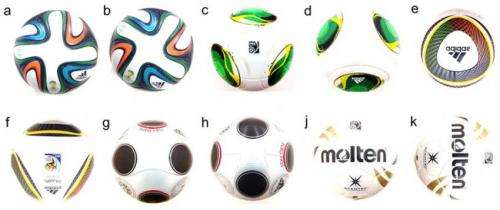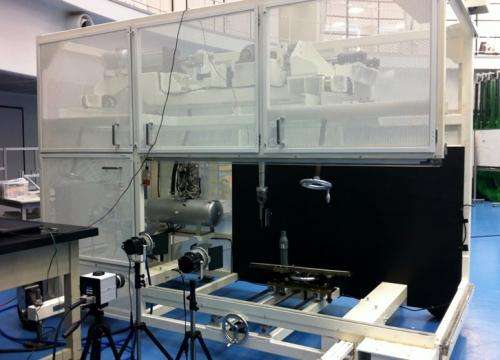June 3, 2014 report
Physicists test aerodynamics of soccer ball types prior to World Cup (w/ Video)

(Phys.org) —A pair of physicists with Japan's University of Tsukuba has tested the aerodynamics of several types of soccer balls to determine which fly the most true when kicked. Sungchan Hong and Takeshi Asai report their findings in a paper they've had published in Scientific Reports.
For most of modern history, soccer balls didn't inspire much conversation prior to, and during World Cup competition, they were all made in the familiar 32 (hand-stitched) panel format. That all changed in 2006, however, when Adidas (official ball supplier) decided to make some changes. First came the Teamgeist, a ball with just 14 panels. The 8-panel Jabulani ball followed in 2010. This time around, Adidas has created a ball called the Brazuca—it has just 6 panels. But the real question is, does it matter?
It clearly matters to players—they criticized the Jabulani, claiming it was erratic, tending to break in odd ways during play. While it's likely that losing teams were more likely to complain about the ball type being used, few believe it played much of a role in who won or lost a match, since both teams used the same ball. Still, most would also probably agree that it would be nice to know which types of balls work better than others. To find out Hong and Asai collected samples of all of the new types of balls introduced by Adidas, along with some of the original design and tested them all using robots kicking balls in a wind tunnel.
In analyzing the results, the research duo corroborated the claims made by players in 2010—the Jabulani performed the worst of all those tested. The newest incarnation, the Brazuca performed best, remaining most true when kicked, followed by the old 32 panel standard. The Teamgeist was only slightly better than the Jabulani.
The outcome should not be surprising, Adidas put a lot of research into creating the new ball design this time around. In addition to gluing the panels on, they also added nearly imperceptible nubs that reduce what are known in the game as knuckling effects. Also, the seams are three times deeper than other balls as well, which means less drag. Once the company had a finished product, they put it to the test—over the course of three years the ball was used by more than 600 players in practice. Hopefully that will translate to good play this World Cup, with conversation focused on players and teams, rather than the balls they are kicking.

More information: Effect of panel shape of soccer ball on its flight characteristics, Scientific Reports 4, Article number: 5068 DOI: 10.1038/srep05068
Abstract
Soccer balls are typically constructed from 32 pentagonal and hexagonal panels. Recently, however, newer balls named Cafusa, Teamgeist 2, and Jabulani were respectively produced from 32, 14, and 8 panels with shapes and designs dramatically different from those of conventional balls. The newest type of ball, named Brazuca, was produced from six panels and will be used in the 2014 FIFA World Cup in Brazil. There have, however, been few studies on the aerodynamic properties of balls constructed from different numbers and shapes of panels. Hence, we used wind tunnel tests and a kick-robot to examine the relationship between the panel shape and orientation of modern soccer balls and their aerodynamic and flight characteristics. We observed a correlation between the wind tunnel test results and the actual ball trajectories, and also clarified how the panel characteristics affected the flight of the ball, which enabled prediction of the trajectory.
Journal information: Scientific Reports
© 2014 Phys.org




















